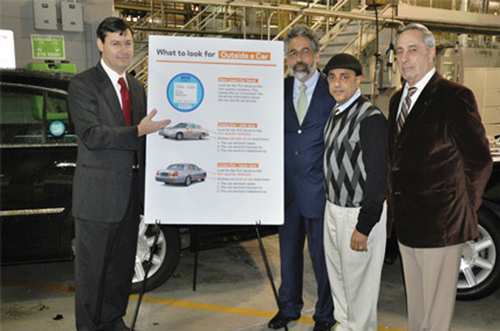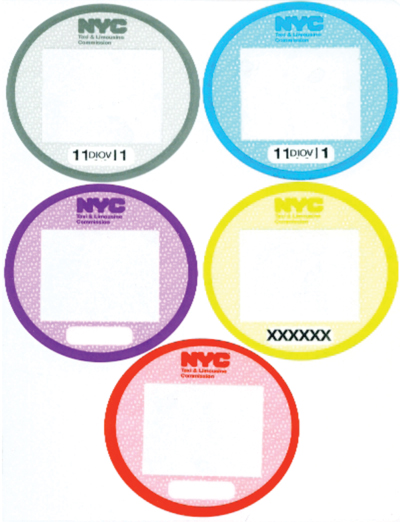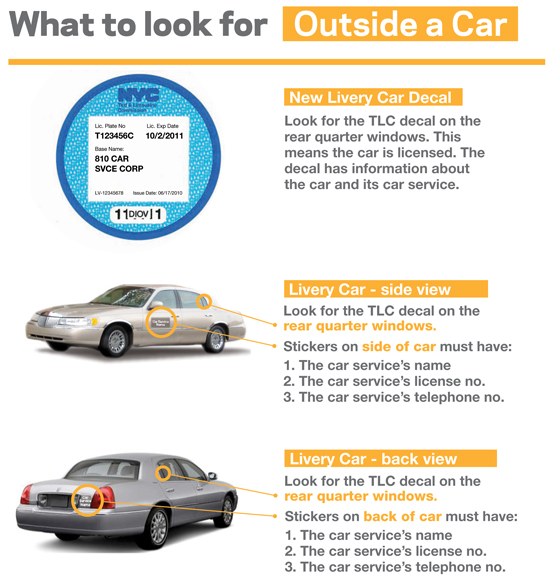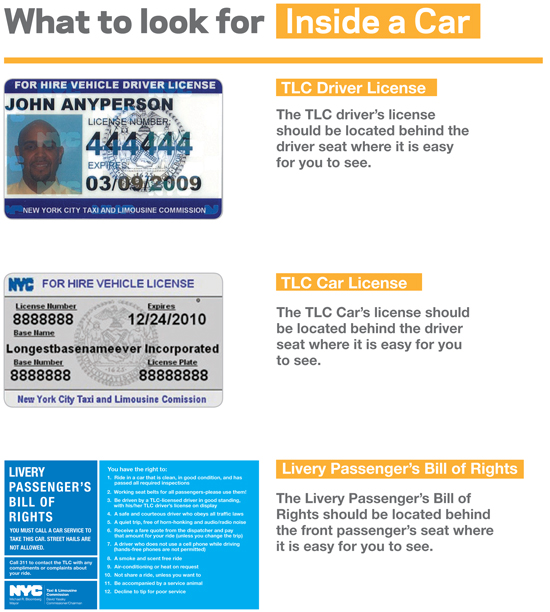![]() NEWS
NEWS
NEW TOOLS TO HELP THE RIDING PUBLIC CHOOSE SAFE, LEGAL FOR-HIRE VEHICLE SERVICES
New Tools to Help The Riding Public Choose Safe, Legal For-Hire Vehicle Services
On November 4, 2010, New York City Taxi and Limousine Commission (TLC) Commissioner David Yassky demonstrated new tools to help the riding public choose safe, legitimate, licensed livery and For-Hire Vehicle (FHV) services and to use these services in the correct ways to maximize safety and accountability.
“We have new tools to help people who use TLC licensed for-hire vehicles to enhance their safety and convenience,” said Commissioner Yassky, “and the more people know about them, the more empowered they are to make smart, informed decisions about the services they use. The key is accountability, and our inspection of all for-hire vehicles, the new markings we’ll be seeing on all FHVs, and the posting of TLC licenses and passengers Bills of Rights we’ll see in every legitimate vehicle assures accountability.”
There are approximately 50,000 TLC-licensed For-Hire Vehicles in the City of New York including liveries (community car services), Black Cars, luxury limousines, paratransit vehicles (ambulettes) and commuter vans. For the first time, each type of FHV licensed by the TLC will be uniformly marked with a specially designed color coded, non-transferable decal that ensures the vehicle is affiliated with a licensed base.
Also, for the first time, all FHVs will feature the posted TLC credential of their drivers allowing passengers to know to whom they are entrusting their safety. In another first, passengers will also be seeing a “Passenger Bill of Rights” in each FHV tailored to each of the individual industries.
“We are confident that our efforts will help people to make the smart decisions to avoid hailing illegal services with questionable drivers, inadequate or no insurance and sketchy backgrounds,” concluded Commissioner Yassky, “and bypass the risks that come with them by prearranging service with a safe, legitimate provider.”
To find a licensed FHV base use the TLC’s “Find-A-Ride” application available by visiting www.nyc.gov/taxi, and clicking on Passenger Information.

TLC Commissioner David Yassky, at left, highlights what consumers should see on the exterior of a legitimate licensed car service vehicle as For-Hire Vehicle industry leaders (from left to right) Tarek Mallah, GM of Dial 7 Car Service; Jose Villoria, President of the NYS Federation of Taxi Drivers; and Livery Round Table President Guy Palumbo look on.
What the decals look like

What To look For in a Livery Cab


NEW YORK CITY TAXI & LIMOUSINE COMMISSION NOTICE OF OPPORTUNITY TO PARTICIPATE IN A PILOT PROGRAM TO TEST LIVERY STANDS AT SELECT LOCATIONS
We have extended the DEADLINE for responses to the Livery Stand Pilot Program to give additional time to interested parties to submit responses to the pilot. The new deadline is January 31, 2011.
The New York City Taxi and Limousine Commission (“TLC”) invites interested parties to submit a request to participate in a pilot program to pilot livery stands at select locations throughout the five boroughs of New York.
The Livery Stands Pilot Program will designate livery stands at privately owned locations throughout the five boroughs. The pilot program, which will be one year in duration, will allow owners or operators of private property at locations within shopping centers, Business Improvement Districts, and other well trafficked locations to contract with livery bases to provide transportation services on site via a “satellite base.” This pilot program will test the use of licensed livery vehicles and livery stands to enhance service to passengers providing for more prompt, efficient, accountable and reliable dispatched service from satellite base locations. Please note, participation in a TLC pilot program in no way guarantees Commission approval for the proposer’s livery stand after conclusion of the pilot program.
On May 28, 2009, the Commission voted to approve this pilot program without limit to the number of participants. It is anticipated that there will be multiple locations citywide with a tentative goal of at least two stands in each borough. In order for your proposal to be considered for participation in this pilot program your proposal should include the requirements listed in the:
SECTION A
Business Plan Requirements for Pilot Proposal
Additional required information that should be included in the Business Plan proposal:
PLEASE NOTE—No base will be permitted to participate that does not have:
SECTION B
Proposal Content Requirements
(a) Applicants should provide a brief narrative and description of the location and businesses in the area where proposed services are to be provided. The narrative should include demonstration of a need for livery services at the proposed location; for example, the lack of availability of alternative modes of transportation such as medallion taxis and appropriate mass transit and/or the presence of significant utilization of livery vehicles.
(b) Applicants must propose a specific, fixed location for the livery stand. The location should be a well trafficked, easily accessible spot. Please include an aerial or other appropriate map showing the exact location. TLC may accept or reject proposed locations in its sole discretion, and applications without a proposed location that is acceptable to TLC will be considered incomplete.
(c) Applicants must describe in detail how they plan to provide “dispatched” transportation services at the proposed location. This should include hours of operation, on site dispatch staffing levels, and on site non-staffed dispatching methods (e.g., courtesy telephones, etc.). Since all rides require dispatch TLC will look more favorably upon programs that offer staffed dispatching during all hours of the facility’s operation.
(d) Applicants must demonstrate the capability to provide sufficient off street vehicle space to allow for orderly dispatching.
(e) Applicants must provide a signage plan that will direct people to the stand and clearly explain the services provided and hours of operation.
(f) Applicants must provide a fare chart for common destinations from the dispatch location. This fare chart will remain in effect for the duration of the pilot and must be available for viewing at the stand.
SECTION C
TLC Evaluation Assessment Guidelines
TLC criteria for evaluation of proposals to determine proposal merit. Proposals should address the following items:
(1) Estimated volume of usage:
(a) Number of vehicles to be dispatched;
(b) Number of passengers estimated to be served;
(c) Measures of anticipated peak usage times and dates.
(2) Proposed location:
(a) Neighborhood location and communities served;
(b) Businesses in the area; local attractions;
(c) Other available forms of public transportation in the area.
3) Proposed property owner/operator and partnership:
SECTION D
MOU requirements for reporting performance and success of program.
Each pilot program participant should submit to the Chairperson a report on the first six (6) months of performance based on evaluation criteria called for in the MOU. This report must be submitted to the Chairperson no later than seven (7) months after the first dispatch. The report should include assessment of the following items:
Volume of Usage:
Property owner/operator satisfaction:
Passenger and Community Satisfaction:
Base owner satisfaction:
Driver satisfaction:
Constituent satisfaction:
Participants and TLC licensees should also provide additional information as requested by the Chairperson. A Memorandum of Understanding (“MOU”) or other binding agreement with TLC is required to initiate the pilot but not needed for submission. TLC may terminate the pilot at any time at the discretion of the Chairperson. Requisites shall include, but will not be limited to, the following provisions:
(1) A participant is required to begin actively dispatching vehicles from the selected location within three (3) months of signing an MOU or binding agreement with the Chairperson.
(2) If a participant has not signed an MOU with the Chairperson within six (6) months of the Commission’s approval of the Pilot Program the participant’s request to participate will have been deemed to be withdrawn.
(3) Signage, courtesy telephones, and all other associated equipment related to the dispatch of vehicles may not be displayed or used for dispatch following completion of pilot program or cancellation of MOU unless rulemaking action is taken by the Commission approving such display or use.
(4) Vehicles used in this pilot must have a current valid TLC vehicle license.
(5) All participating drivers must have a current TLC FHV operator’s license that is neither suspended nor revoked.
Participation proposals will be reviewed in accordance with the standards of review and approval stated in TLC Rule 14-04.
For more information see link below:
http://nyc.gov/html/tlc/downloads/pdf/rules_pilot_program_approved.pdf
Pilot program proposals, suggestions or ideas should be submitted by January 31, 2011 to:
Tweeps Phillips
Director for Special Projects
New York City Taxi and Limousine Commission
40 Rector Street, 5th Floor
New York, NY 10006
Tweeps.Phillips@tlc.nyc.gov
TLC staff is available to meet with interested parties to further explore proposals submitted or to discuss proposal ideas prior to submission. Please contact Tweeps Phillips at 212-676-1010 or via e-mail at Tweeps.Phillips@tlc.nyc.gov.
Industry Notice #10-25 • November 10, 2010
REMINDER: GROUP RIDE STAND AT E. 79TH ST. & YORK AVE. IS A DUAL USE STAND!
Passengers May Request Either Group OR Regular Rides!
The New York City Taxi and Limousine Commission’s (NYC TLC) taxi group ride stand at East 79th Street and York Avenue is currently operating as a dual use stand:
Industry Notice #10-23 • November 1, 2010
ATTENTION DRIVERS: NEW TAXI RELIEF STAND ESTABLISHED ON PARK ROW
In conjunction with the NYC Department of Transportation and the Downtown Alliance, the New York City Taxi and Limousine Commission has established a new taxi relief stand on the south side of Park Row between Ann Street and Beekman Street next to the J&R Electronics store.
The relief stand has two (2) spaces and is reserved for taxicabs seven (7) days a week, from 9 a.m. to 10 p.m. Taxicab drivers are entitled to park in one of the reserved spaces for up to one (1) hour, use the J&R bathroom which is located on the lower level, and are welcome to enjoy free coffee on the mezzanine level of the store.
For more information on this and other taxi relief stands go to:
http://www.nyc.gov/html/dot/html/motorist/taxirelief.shtml.